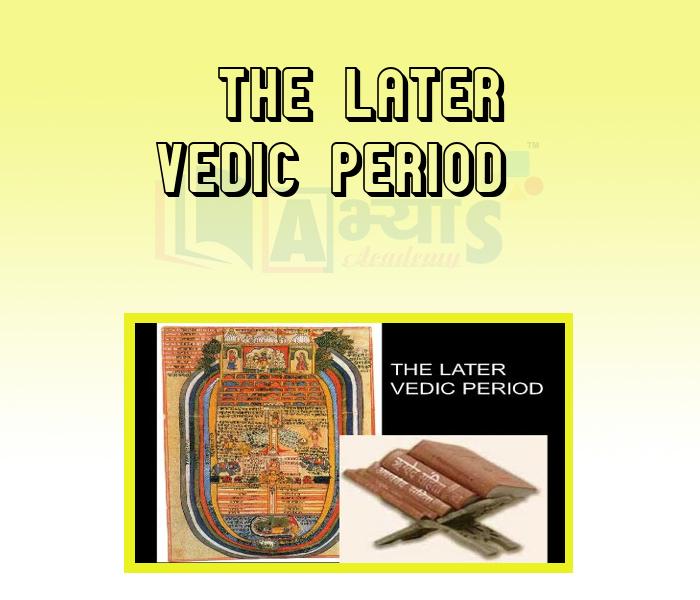The Later Vedic Period

The Later Vedic Period
Later Vedic period: The rest of the three Vedas, namely the Sama Veda, the yajur Veda and the Atharva Veda were composed during this period. The Ramayana, Mahabharata and some parts of puranas were also composed during this period. The Ramayana was written by Valmiki and the Mahabharata was written by Veda Vyasa.
Political life: The Rajan was no more a tribal chief now. He was now a king with a proper kingdom and a big army at his disposal. The extent of his kingdom determined his power and status. The rajan now enjoyed the titles like Samrat and Maharajadhiraja.
Economic life: Besides the Vedas, the excavations at various sites like Hastinapur, Kausambi and Atranjikhera in Uttar Pradesh have discovered remains of mud walls with pieces of mud bricks and burnt bricks. Bamboo poles were used for building roofs in these houses. The floors were made of fine yellowish earth. Large quantities of wheat, rice and barley have been found that the Vedic men must have grown. Ploughing was done with wooden ploughshares.
Society: The position of women became inferior to men. Even though the presence of women was essential in religious ceremonies, still they occupied a lower position in society. Their education had also taken a backseat. The family continued to be the basic unit of society with the father as head of the family. The boys were sent to gurukula to study in the same way as in the early Vedic period.
Difference between Early Vedic Period and later Vedic Vedic Period
| Early Vedic Period | Later Vedic Period |
| The caste system was Flexible and based on profession rather than birth. | The caste system became more rigid in this period with birth being the main criteria. |
| There was no concept of Shudra or Untouchables | Shudras became a main stay in the later vedic period.Their sole functions was to serve those of the upper -caste. |
| women were allowed a greater degree of freedom in this period.They were allowed to participate in the political process of the time to a certain extent. | women were restricted from their participation in society by being relegated to subordinate and docile roles. |
| Early Vedic society was pastroralist and semi nomadic in nature. | Society became more settled in nature .It became centred around agriculture in general. |
| Rigveda This text is cited as the earliest text from this period. | Yajurveda ,samaveda,Atharveda |
Students / Parents Reviews [10]
Being a parent, I saw my daughter improvement in her studies by seeing a good result in all day to day compititive exam TMO, NSO, IEO etc and as well as studies. I have got a fruitful result from my daughter.

Prisha Gupta
8thMy experience was very good with Abhyas academy. I am studying here from 6th class and I am satisfied by its results in my life. I improved a lot here ahead of school syllabus.

Ayan Ghosh
8thAbhyas Methodology is very good. It is based on according to student and each child manages accordingly to its properly. Methodology has improved the abilities of students to shine them in future.

Manish Kumar
10thMy experience with Abhyas academy is very good. I did not think that my every subject coming here will be so strong. The main thing is that the online tests had made me learn here more things.

Hiya Gupta
8thIt has a great methodology. Students here can get analysis to their test quickly.We can learn easily through PPTs and the testing methods are good. We know that where we have to practice

Barkha Arora
10thIt was a good experience with Abhyas Academy. I even faced problems in starting but slowly and steadily overcomed. Especially reasoning classes helped me a lot.

Cheshta
10thAbhyas is a complete education Institute. Here extreme care is taken by teacher with the help of regular exam. Extra classes also conducted by the institute, if the student is weak.

Om Umang
10thI have spent a wonderful time in Abhyas academy. It has made my reasoning more apt, English more stronger and Maths an interesting subject for me. It has given me a habbit of self studying

Yatharthi Sharma
10thOne of the best institutes to develope a child interest in studies.Provides SST and English knowledge also unlike other institutes. Teachers are co operative and friendly online tests andPPT develope practical knowledge also.

Aman Kumar Shrivastava
10thMy experience with Abhyas is very good. I have learnt many things here like vedic maths and reasoning also. Teachers here first take our doubts and then there are assignments to verify our weak points.











